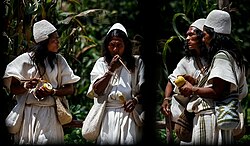
Back Amerindis de Colòmbia Catalan Población indígena de Colombia Spanish بومیهای کلمبیا Persian Pobos indíxenas de Colombia Galician Penduduk asli di Kolombia ID Popoli indigeni della Colombia Italian Xwecihên Kolombiyayê Kurdish കൊളംബിയയിലെ തദ്ദേശവാസികൾ Malayalam Urfolk i Colombia NN Kolombiya Kızılderilileri Turkish
 | |
 Arhuaco Amerindians in the Sierra Nevada de Santa Marta Mountains. | |
| Total population | |
|---|---|
| 1,905,617 (2018 Census) 4.31% of Colombia's population[1][2] c. 5,200,000 (Estimation) ~10% of Colombia’s population[3][4][5] 1.8%,[6] 2%,[7][8] 9.5%[9] or 10.4%[4] of Colombians (external sources) | |
| Regions with significant populations | |
| Throughout the country, especially in Andean Highlands, Caribbean Region and Amazonía Region | |
| Languages | |
| Indigenous languages and Spanish | |
| Religion | |
| Roman Catholicism, Native American religions |
Indigenous peoples of Colombia are the ethnic groups who have inhabited Colombia since before the Spanish colonization of Colombia, in the early 16th century.
Estimates on the percentage of Colombians who are indigenous vary, from 3% or 1.5 million to 10% or 5 million. According to the 2018 Colombian census, they comprise 4.4% of the country's population, belonging to 115 different tribes, up from 3.4% in the 2005 Colombian census.[1][2] However, a Latinobarómetro survey from the same year found that 10.4% of Colombian respondents self-identified as indigenous.[4][5] The most recent estimation of the number of indigenous peoples of Colombia places it at around 9.5% of the population and has been growing since an all-time low of 1965, where it was estimated only 1% of Colombians were indigenous.[10] The 2023 estimate indicates Colombia as having the seventh highest percentage of Amerindians in the Americas with only Bolivia, Chile, Ecuador, Guatemala, Peru, and Panama having a higher estimated percentage of Amerindians than Colombia.[11]
Approximately two thirds of the registered Indigenous peoples live in La Guajira, Cauca, Nariño, Córdoba and Sucre Departments. Amazon Basin, a sparsely populated region, is home to over 70 different Indigenous ethnic groups.[1]
Both historically and in recent times, they have been subjected to violence and oppression, ranging from land theft to massacres to the targeted killings of Indigenous activists and politicians.[12]
- ^ a b c "Indigenous peoples in Colombia". International Work Group for Indigenous Affairs. Retrieved 11 Dec 2013.
- ^ a b https://www.dane.gov.co/files/investigaciones/boletines/grupos-etnicos/presentacion-grupos-etnicos-2019.pdf [bare URL PDF]
- ^ "Raza/Etnia a la que pertenece". Latinobarómetro 2023 Colombia. Retrieved 13 February 2024.
- ^ a b c "Informe Latinobarómetro 2018". Latinobarometro. Retrieved October 3, 2022.
- ^ a b "Informe Latinobarómetro". Latinobarometro. Retrieved January 30, 2024.
- ^ Lizcano Fernández, Francisco (2005). "Composición Étnica de las Tres Áreas Culturales del Continente Americano al Comienzo del Siglo XXI" [Ethnic Composition of Three Cultural Areas of the Americas at Beginning of the XXI Century] (PDF). Convergencia (in Spanish). 38 (May–August): 185–232. ISSN 1405-1435. Archived from the original (PDF) on September 20, 2008: see table on page 218
- ^ Simon Schwartzman. "Étnia, condiciones de vida y discriminación" (PDF). Retrieved 2 March 2022.
- ^ Ruiz-Linares, Andrés; Adhikari, Kaustubh; Acuña-Alonzo, Victor; Quinto-Sanchez, Mirsha; Jaramillo, Claudia; Arias, William; Fuentes, Macarena; Pizarro, María; Everardo, Paola; Avila, Francisco de; Gómez-Valdés, Jorge (2014-09-25). "Admixture in Latin America: Geographic Structure, Phenotypic Diversity and Self-Perception of Ancestry Based on 7,342 Individuals". PLOS Genetics. 10 (9): e1004572. doi:10.1371/journal.pgen.1004572. ISSN 1553-7404. PMC 4177621. PMID 25254375.
- ^ "Raza/Etnia a la que pertenece". Latinobarómetro 2023 Colombia. Retrieved 13 February 2024.
- ^ Rueda, Ricardo (1974). La población de Colombia. Asociación Colombiana para el Estudio de la Población. p. 78.
- ^ "Raza/Etnia a la que pertenece". Latinobarómetro 2023 Colombia. Retrieved 13 February 2024.
- ^ Alexander, Inigo. "Colombia's Indigenous population faces scourge of violence". Al Jazeera. Retrieved 12 December 2023.
© MMXXIII Rich X Search. We shall prevail. All rights reserved. Rich X Search